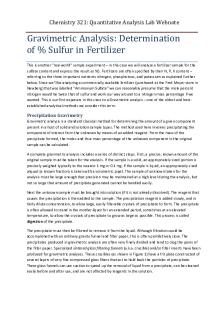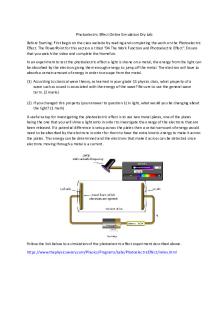Gravimetric Analysis Practice Dry Lab PDF

| Title | Gravimetric Analysis Practice Dry Lab |
|---|---|
| Author | Datcayani V Karuppiah |
| Course | Chemistry |
| Institution | Harvard University |
| Pages | 3 |
| File Size | 127.4 KB |
| File Type | |
| Total Downloads | 104 |
| Total Views | 137 |
Summary
This is a practice analysis dry lab regarding gravimetric. Uses your knowledge of limiting and excess reagents to determine the percent yield of a precipitate from a double displacement reaction between lead II nitrate and potassium iodide....
Description
SCH 3U0/E Name:______________ Determining Percentage Yield from a Double
Displacement Reaction Purpose: (1 mark) In this dry lab, you will use your knowledge of limiting and excess reagents to determine the percent yield of a precipitate from a double displacement reaction between lead II nitrate and potassium iodide. Balanced Chemical Equation:
Materials: (1 mark) Assemble this list into a labelled diagram of the apparatus: funnel, 2-250 mL beakers, wash bottle, stirring rod, filter paper, electronic balance, distilled water, graduated cylinder, weighing boat, lead II nitrate, potassium iodide, scoopula
Method: do not write this out in your report as you will not get any marks for it. It's solely so that you can visualize the experimental protocol. 1. Mass out 1.32 g of lead II nitrate into a weighing boat. Record the mass. 2. Carefully transfer the lead II nitrate into a clean 250 mL beaker. Use a wash bottle to rinse the weighing boat and transfer the residue into the beaker. 3. Add 25 mL of distilled water to the beaker and stir to dissolve. 4. Mass out 0.60 g of potassium iodide into a weighing boat. Record the mass. 5. Carefully transfer the potassium iodide into a clean 250 mL beaker. Use a wash bottle to rinse the weighing boat and transfer the residue into the beaker. 6. Add 25 mL of distilled water to the beaker and stir to dissolve. 7. Transfer the solution of lead II nitrate into the beaker with the solution of the potassium iodide. Use a wash bottle to rinse the beaker and transfer all residual liquid to the reaction beaker. Observe the precipitate and record your qualitative observations in the table. 8. Mass a piece of filter paper and record the mass. 9. Set up the filtration apparatus as shown on page 327 in your textbook. 10. Carefully pour the contents of your reaction beaker into the filter paper in the funnel ensuring it does not overflow. 11. Continue until the entire mixture has been filtered. Be sure to rinse your beaker to
ensure as much of your precipitate is collected. 12. When filtration is complete, remove the filter paper from the funnel and set aside on a piece of paper towel to dry. 13. Measure the mass of the filter paper and precipitate after 24 hours and then again after 48 h. Record the mass each time. 14. Dispose of your filter paper and precipitate in the garbage can.
Observations: (1 mark) Table 1.0: Mass Data and Qualitative Observations for the Reaction of Lead II nitrate and Potassium iodide ** ensure 2 last rows are filled in
QUANTITY MASS (g) Lead II nitrate 1.32 Potassium iodide 0.60 Filter paper 1.25 Filter paper and precipitate after 24 h 2.21 Filter paper and precipitate after 48 h 2.04 Mass of precipitate 0.83g Physical Properties of precipitate:
Calculations and Analysis: Neatly complete each question showing all your work for each calculation including units and significant figures. 1. Determine which reactant is present in limiting quantities. (5 marks) 2. Determine the theoretical yield of precipitate. (2 marks) 3. Determine the experimental yield of the product. (2 marks) 4. Calculate the percent yield of the product? (2marks) 5. Calculate the mass of excess reagent that was consumed in the reaction. (4 marks) 6. What mass of excess reagent remains unreacted at the end of the experiment? (2 marks) 7. Was an acceptable amount of excess reagent used in this experiment according to industry standards? Explain your answer. (2 marks) 8. Discuss 3 sources of error and how each error would affect the experimental yield of
precipitate. (3 marks)
Total Marks: /25 Marking Scheme: Purpose 0 1 Materials 0 1 Observations 0 1 Calculations ● 1. 0 1 2 3 4 5 ● 2. 0 12 ● 3. 0 1 2 ● 4. 0 1 2 ● 5. 0 1 2 3 4 ● 6. 0 12 ● 7. 0 1 2 ● 8. 0 1 2 3 Total: 25 marks...
Similar Free PDFs

Chem dry lab d
- 3 Pages

Dry Lab 2b - Chem 1310 2B dry lab
- 13 Pages

Dry Lab 2B and 2C Assignment
- 4 Pages

Gravimetric - experiment
- 11 Pages
Popular Institutions
- Tinajero National High School - Annex
- Politeknik Caltex Riau
- Yokohama City University
- SGT University
- University of Al-Qadisiyah
- Divine Word College of Vigan
- Techniek College Rotterdam
- Universidade de Santiago
- Universiti Teknologi MARA Cawangan Johor Kampus Pasir Gudang
- Poltekkes Kemenkes Yogyakarta
- Baguio City National High School
- Colegio san marcos
- preparatoria uno
- Centro de Bachillerato Tecnológico Industrial y de Servicios No. 107
- Dalian Maritime University
- Quang Trung Secondary School
- Colegio Tecnológico en Informática
- Corporación Regional de Educación Superior
- Grupo CEDVA
- Dar Al Uloom University
- Centro de Estudios Preuniversitarios de la Universidad Nacional de Ingeniería
- 上智大学
- Aakash International School, Nuna Majara
- San Felipe Neri Catholic School
- Kang Chiao International School - New Taipei City
- Misamis Occidental National High School
- Institución Educativa Escuela Normal Juan Ladrilleros
- Kolehiyo ng Pantukan
- Batanes State College
- Instituto Continental
- Sekolah Menengah Kejuruan Kesehatan Kaltara (Tarakan)
- Colegio de La Inmaculada Concepcion - Cebu











